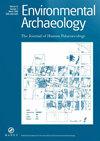生活在变化中:人类与环境相互作用的考古学。特刊简介
IF 1.1
3区 地球科学
0 ARCHAEOLOGY
引用次数: 0
摘要
人类作为环境变化的推动者的角色是远远超出考古学学科的辩论的中心。生活的必需品,如食物、燃料、住所和物质工艺品,与自然资源的开采有着根本的关系。鉴于资源利用的普遍性,人类活动对塑造我们周围的世界产生了深远的影响,随着当前的全球政治和对环境变化威胁的日益认识,近年来环境考古学的声音越来越大也就不足为奇了。在过去人类与环境关系研究的前沿,环境考古学家敏锐地探索生活在长期和短期环境变化中意味着什么,从过去和最近的过去及其持续的后果中,对人类与环境的相互作用做出了强有力的、基于证据的解释(Dearing等人,2006;d 'Alpoim Guedes et al. 2016)。这种探索不仅包括由人类活动引起的地方和区域环境的变化(例如Fairhead和Leach 1996;瑞德曼1999;Butzer 2005),但也包括人类行为本身受到动态和不断变化的环境刺激的反应(例如Rockman和Steele 2003;Cooper and Sheets 2012;金泰和英格拉姆2018)。这些主题的重要性反映在考古学传统边界之外的学科日益扩大的范围中(例如Sandweiss和Kelley 2012;Guttmann-Bond 2019;不过请参阅Richer et al. 2019的评论)。在这个更广泛的框架内,本期特刊汇集了2019年在谢菲尔德大学举行的环境考古协会第40届会议上发表的一系列论文。这次会议提供了一个机会来反思该学科的过去,并在不断增长的数据体、多种变化代理的整合、新的分析技术和新的理论范式的背景下讨论其未来。会议的呼吁是广泛的,反映了环境考古学下的子学科的广度,但敦促论文从人类的角度探索环境变化,通过参与变化、适应、可持续性和人类影响等问题。环境考古协会(AEA)在过去的40年里一直走在环境考古的前沿。在英国开始作为一个新兴领域的专家之间的沟通手段,该协会已经发展成为一个国际机构,适应不断发展和扩大的方法环境考古学现在包含。美国环境学会倡导研究人类与环境之间的关系,以及这种关系对人类社会发展的影响,以及我们对周围世界的影响。第四十届美国环境考古学会秋季会议的出席人数众多,反映了环境考古的健康和吸引力,共有153名注册代表,其中70名是美国环境考古学会会员(图1)。与许多考古学会议不同的是,只有63%的会议来自学术界,28%来自商业部门和政府机构,突出了这门学科在学术界之外的重要性。代表们大多在英国,但环境考古学的全球影响力很明显,代表们来自日本、俄罗斯、波兰、德国、意大利、罗马尼亚、西班牙、爱尔兰、荷兰和瑞士。谢菲尔德大学(University of Sheffield)是本届美国经济学会成立40周年的合适东道主。格利尼斯·琼斯,他加入了谢菲尔德大学考古学系本文章由计算机程序翻译,如有差异,请以英文原文为准。
Living Through Change: The Archaeology of Human-Environment Interactions. Introduction to the Special Issue
The role of humans as agents of environmental change is central to debates far beyond the discipline of archaeology. Life’s essentials such as sustenance, fuel, shelter and material crafts have a fundamental relationship to the exploitation of natural resources. Given this pervasiveness of resource use, human action has had a profound influence on shaping the world around us, and with current global politics and a growing recognition of the threats of environmental change, it is not surprising that the voices of environmental archaeology have grown much louder in recent years. At the forefront of the study of past humanenvironment relationships, environmental archaeologists are keenly placed to explore what it means to live through longand short-term environmental change, contributing powerful and evidence-based accounts of human-environment interactions from the deep and recent past and their on-going ramifications (Dearing et al. 2006; d’Alpoim Guedes et al. 2016). Such explorations encompass not only changes to local and regional environments precipitated by human activity (e.g. Fairhead and Leach 1996; Redman 1999; Butzer 2005), but also the responses in human behaviour that are themselves stimulated by dynamic and changing environments (e.g. Rockman and Steele 2003; Cooper and Sheets 2012; Kintigh and Ingram 2018). The importance of these themes is reflected in the increasing reach of the discipline outside of the traditional boundaries of archaeology (e.g. Sandweiss and Kelley 2012; Guttmann-Bond 2019; though see Richer et al. 2019 for commentary). Within this broader framework, this special issue brings together a selection of papers presented at the 40th conference of the Association of Environmental Archaeology held in 2019 at the University of Sheffield. This conference provided an opportunity to reflect on the discipline’s past, and debate its future in the context of growing bodies of data, the integration of multiple proxies for change, new analytical techniques and fresh theoretical paradigms. The call for the conference was broad, reflecting the breadth of sub-disciplines that fall under the umbrella of environmental archaeology, yet urged for papers that explored environmental change from the human perspective, through engagement with questions of change, adaptation, sustainability and human impact. The Association for Environmental Archaeology (AEA) has been at the forefront of environmental archaeology for the past 40 years. Beginning in the UK as a means of communication between specialists in an emerging field, the Association has developed into an international body adapting to the evolving and expanding approaches environmental archaeology now encompasses. The AEA champions the study of the relationship between humans and the environment, and the implications of that relationship for the development of human society and our impact on the world around us. The health and appeal of environmental archaeology is reflected by the strong attendance at the 40th AEA Autumn conference, with 153 registered delegates, of whom 70 were AEA members (Figure 1). Unlike many archaeology conferences, only 63% of these were from academia, with 28% from the commercial sector and government agencies highlighting the importance of the discipline outside the academic world. Delegates were mostly based in the UK, but the global reach of environmental archaeology was apparent with delegates having travelled from Japan, Russia, Poland, Germany, Italy, Romania, Spain, Ireland, the Netherlands and Switzerland. The University of Sheffield was a fitting host for this 40th anniversary of the AEA. Glynis Jones – who joined the Department of Archaeology at Sheffield in
求助全文
通过发布文献求助,成功后即可免费获取论文全文。
去求助
来源期刊

Environmental Archaeology
GEOSCIENCES, MULTIDISCIPLINARY-
CiteScore
4.80
自引率
0.00%
发文量
32
期刊介绍:
Environmental Archaeology: The Journal of Human Palaeoecology aims to publish contributions on all aspects of environmental archaeology, from methodology to synthesis and theory.
Environmental Archaeology is an international peer-reviewed periodical which welcomes contributions that consider the interaction between humans and their environment in the archaeological and historical past. This broad scope embraces papers covering a range of environmental specialisms within archaeology, such as archaeobotany, archaeozoology (both vertebrate and invertebrate), palynology, geoarchaeology, biological anthropology, as well as more synthetic and theoretical approaches to the past human environment. Assemblage and site reports are not encouraged unless these can demonstrate significant new insights in environmental archaeology. Contributions may take the form of substantial research papers or shorter reports and may include, for instance, new techniques, philosophical discussions, current controversies and suggestions for new research. The journal also provides its readership with critical appraisal of recent academic scholarship through its regular books review section.
 求助内容:
求助内容: 应助结果提醒方式:
应助结果提醒方式:


